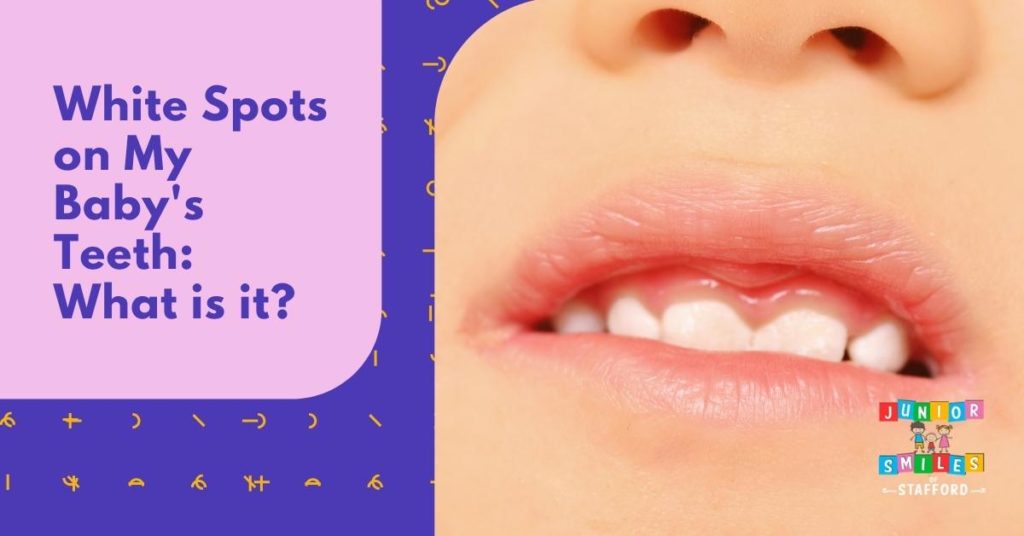White Spots on My Baby’s Teeth: What is it?

It’s not new for parents to worry about their child, even about the white spots on baby teeth—it’s okay. A little white spot on your child’s teeth leaves you wondering what it is and how it came to be there. Too much fluoride in your child’s water might cause white spots on toddler’s teeth, which can be an early indicator of tooth rot. You should not ignore these white spots on teeth, so let’s go over the two causes of these!
Causes of White Spots on Teeth
Tooth Decay
A white spot on your child’s teeth could be a sign of tooth decay. How could that happen? The chalky, pale appearance of these white patches can be seen along your child’s gumline. There is a good chance that they will become brown or yellow as the decomposition continues. The good news is that tooth decay in children can still be reversed at this point! You can start improving your kid’s oral care habits and start visiting your dentist’s office for treatment. The dentist will remove any plaque and tartar from your child’s teeth and, if necessary, administer fluoride for teeth.
Enamel is the outer covering of teeth that protects them from further stages of tooth decay. And fluoride is a strengthener of tooth enamel; thus, it would be best to introduce fluoride early in their dental care routine.
Read More: Does Milk Cause Tooth Decay in Children? Myths and Facts
Fluorosis
There is a good chance that fluorosis is to blame for the white spots on baby teeth when they emerge. Fluorosis can occur in the form of white streaks, tiny, irregular patches, or a combination of the two, depending on how much fluoride a child is exposed to while their teeth are still forming below the gum line. Fluoride is undoubtedly an essential mineral; however, it can develop problems if excessively used.
Fluoride is not usually harmful, and it may also help your child’s teeth to be more resistant to decay; however, it would still be best to check if your child ingests the right amount of fluoride.
The American Dental Association (ADA) recommends the following strategies to prevent fluorosis:
- Avoid giving your child fluoride supplements unless your dentist prescribes them.
- The appropriate amount of toothpaste should be the same as the size of a grain of rice until your kid is three and a pea-sized amount if your child is 3 to 6 years old.
- Check your area’s public drinking water source to ensure it does not exceed two parts per million.
- It would be best to breastfeed your baby until six months old.
- Mouthwash with fluoride is not advisable. Though, you can incorporate them into your child’s oral care routine when they are six years old.
Treating White Spots on Baby Teeth
A white spot may not be concerning, but it could lead to further oral health problems if left neglected. Once you start noticing white spots on baby teeth, visit your dentist immediately. When detected early, white spot lesions are curable. It is better for the kids and less stressful for everyone if the areas are remineralized as soon as possible.
Frequently Asked Questions
Will the white spots on my child’s teeth go away?
White spots on teeth might fade away on their own, require treatment, or last a lifetime, depending on their underlying cause. White teeth spots that emerge due to dehydration may disappear within a few hours if you leave your mouth open at night. It would be best to consult your dentist if it doesn’t fade within hours.
What vitamin deficiency causes white spots on teeth?
If your child lacks calcium in their diet, it could deprive your body of the building blocks of healthy enamel. Several minerals that are part of a well-balanced diet contribute to the formation of dental enamel, and if you don’t get enough of these minerals, you may notice white patches on your teeth as a result.
Do white spots on teeth mean cavities?
White spot lesions can be one of the early signs of tooth decay. These white spots are signs of mineral loss. Fortunately, this situation can still be reversed. Consult with your dentist as soon as you notice white spot lesions on your teeth, and prevent the cavity from further development.
Contact Junior Smiles of Stafford to know more about how to treat cavities in baby teeth.
Preventing tooth decay is possible. Contact a pediatric dentist if you notice signs of tooth decay or have any other concerns about your child’s dental health. Your child’s teeth can last a lifetime if they are cared for properly.
Read Next: Children’s Teeth Without Enamel: Causes and Treatment
Why Choose Junior Smiles of Stafford?
Our Stafford, VA team is well-versed in working with clients of various ages and backgrounds. They’ll take the time to get to know you and your family’s requirements, and they’ll work with you to design a treatment plan that suits your schedule. Sealants and fluoride treatments are just two of the many preventative care options we provide to keep your mouth healthy.
About Us
Visiting Junior Smiles of Stafford means you’re in good hands when it comes to receiving high-quality care. Your child’s dental health improves with each visit, ensuring a brighter smile for years to come. We adhere to the ADA and AAPD’s guidelines for best practices.
Where Are We Located?
Phone: (540) 699-2441
Fax: (540) 699-2464
Email: info@juniorsmilesofstafford.com
Monday and Tuesday: 9:00 AM – 5:00 PM
Wednesdays and Thursdays: 8:00 AM – 4:00 PM
Fridays and Saturdays: 9:00 AM – 2:00 PM (By appointment only)
How to Book Your Kids First Appointment at Junior Smiles of Stafford
Fill out the form on our website. Within 24 hours, a member of our team will get back to you.

